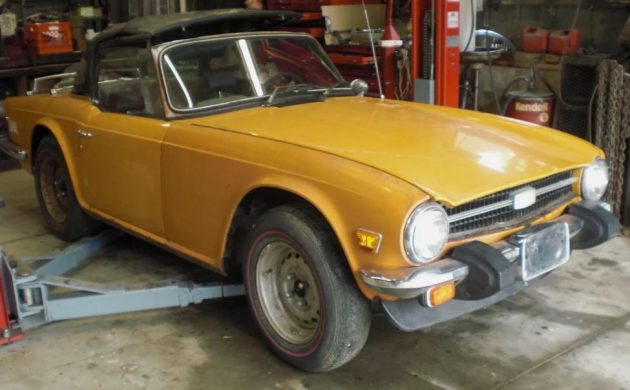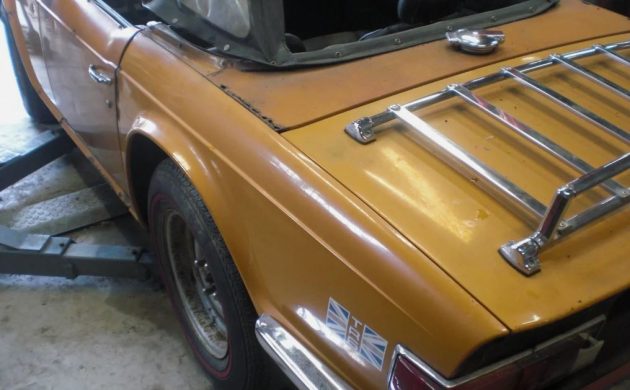Everyone who’s spent serious time wrenching on vintage cars knows the agony: the car you thought had only a little rust turns out to be infested. We all appreciate a forthright seller who warns us ahead of time, and that’s what we have here on eBay, in the form of this 1976 Triumph TR6 project or parts car, bid to $660 with no reserve. The car has been off the road since 1987; the seller originally had his own plans for the car but has lost his storage. The new owner will retrieve the car from Newark, Delaware. Despite its derelict condition, it has virtues – let’s check it out.
As ever with British automakers in the late 1960s, budgets dictated product. Leyland Motors, having bought Triumph in 1960, was absorbed into the Mothership – British Leyland – by 1968, coinciding with the introduction of the TR6. In the melee that preceded these corporate shenanigans, the TR6 found its footing in the design studios of Karmann, the German firm. Karmann used Michelotti’s TR4 as a basis for a slab-sided, masculine interpretation of a sports car, designed to carry Triumph’s six-cylinder engine. The new 2.5 liter six was itself an evolution of the Vitesse’s 2.0 liter six, with its larger displacement generating just over 100 hp (US delivery). In this example, a non-overdrive four-speed gearbox handles shifting. This engine turns over though its carburetors reside in the trunk at the moment.
The interior offers useful bits, including the gauges, switches, some trim, the dash, a steering wheel, seat frames. Parts are easy to acquire, either reproductions or originals from the donor subset of the 91,000 TR6s produced over the years. The driving experience is seductive, though in my quest for my first British car, I eschewed the TR6 in favor of the four-cylinder MGB. The TR6s I drove felt rattly to me, whereas the “B” was nearly a part of the earth – solid, stolid, a brick.
As noted, our seller is forthcoming about this car’s rusty bits – and there are many of those. I always wonder – how does a car rust on its top surfaces? I can concoct many scenarios that explain undercarriage rust, but the topside stretches my imagination. Other than rust, the center floor has been peeled away from its anchor – I know THAT story, and it has to do with shortcutting access to some bit that needs replacement. The car does come with a nice SnugTop hard top, in fair condition with seals intact though requiring re-fitment. Restoring this car is a losing battle if the buyer can’t DIY, and paying for shipping on top of the current bid even makes parting it out a bit of a push. What would you pay for this Triumph project?








In the late ’90s I took on a south Florida rust bucket AH Sprite. All the floor, both outside rocker panels plus the inside of the right side, rear fender opening on both sides, which was OK as we were making a race car that would get flares, the bottoms of the rear fenders and the bottom half of the A pillars. Used up enough sheet steel to build an ark and the welding hours, including the roll cage, was over 200 hours. Stopped counting after that but did promise to never do that again. It turned out to be a great car but I’ve kept my “no more” promise. I’d put a picture up but I get “moderated” when I do. This TR 6 is in the same category in my book. Too bad, they are nice cars.
Seeing where the rust is , I’ve concluded it’s not really rust, but “flow-through ventilation” I think, with the costs of repairing the rust on this car, it may be better used as a parts donor.
I test drove one of these after some maintenance, during a summer job I had working at my car mechanic’s (he had taken me on as a shop hand). I was too afraid to light it up, well, more like I liked my boss too much to do that with one of his customer’s cars. The six cylinder tractor engine in that lightweight chassis, easy clutch, and really directly feeling the gearshift, steering, and everything else… whoa. Totally impractical car for 20 year old me to own, but the short drive around the block made me really want one of my own!
Whoever buys this one will have a labor of love on their hands. The journey (fixing it up) will be as much fun as the destination (putting a license plate on it and taking it out for the first spin) but the new owner had better love wrenching on old machinery!
Nope. Love these but it needs way too much unless as someone said you have the skills and facilities to mostly DIY. Always wanted one but never owned one.
Nice driver quality examples are available in the $20’s and that would be a much easier way to get into the TR-6 world.
SOLD-$830.
Someone got a break on some of the parts needed for their own project, and probably got much of their investment from procuring the hardtop-provided they lived close enough for the seller to make the recovery worthwhile..
I’d agree, at $830 that’s a great value parts car, there is way more than $830 worth of re-usable/sellable parts there. I always feel like it’s a bit of a shame to take a viable car out of circulation that way – but the economics of the situation make it worth more stripped and parted out.
I too have struggled through a body restoration on a “more rust that it looked like” Triumph (TR4) and although it was a good life experience and a character-building challenge completed, I too vowed that I would never buy another project with that level of bodywork needed. …and I have not, so far ! currently have a 1972 Spitfire project that we are rebuilding mechanically, but I bought it specifically because the body was amazingly straight and 99.5% rust-free.
I’ve always liked the idea of a TR6, still relatively affordable, a great combination of performance, vintage charm and mechanical simplicity. I don’t suppose I’ll ever own one now, too many other projects and really a little bit too similar to my TR4 – even though the 6-cylinder and the IRS are a superior combo.
The author’s write-up is slightly misleading. The TR6 was not designed to accommodate the “new” six-cylinder engine, Triumph had already introduced the six-cylinder engine in the TR5/TR250 previously. The TR6 was just a continuation of the TR evolution, mainly a re-style as noted. Karmann were apparently approached as Michelotti was busy with other work at the time. Karmann did a really good job to overhaul the look with really very limited panel changes. The TR6 body shares a great deal under the skin with its TR4/4A, TR5/TR250 predecessors. No doubt it was a relatively cheap job for British Leyland, who really did not have the money to invest in major development work at that time.
Hey JimC2, I think your “tractor engine” jibe here is a little off beam… The six-cylinder engine was not a tractor design, nor used in a tractor? The Standard Vanguard 4-cylinder engine used in the TR2, 3, 4 and TR4A was also sold to Massey Ferguson and used in tractors, though was essentially designed for a car originally. So even calling the Triumph 4-cylinder a “tractor engine” is a bit like calling a Chevy 350 a “boat engine” because Mercury Marine modified some of them for use in power boats.